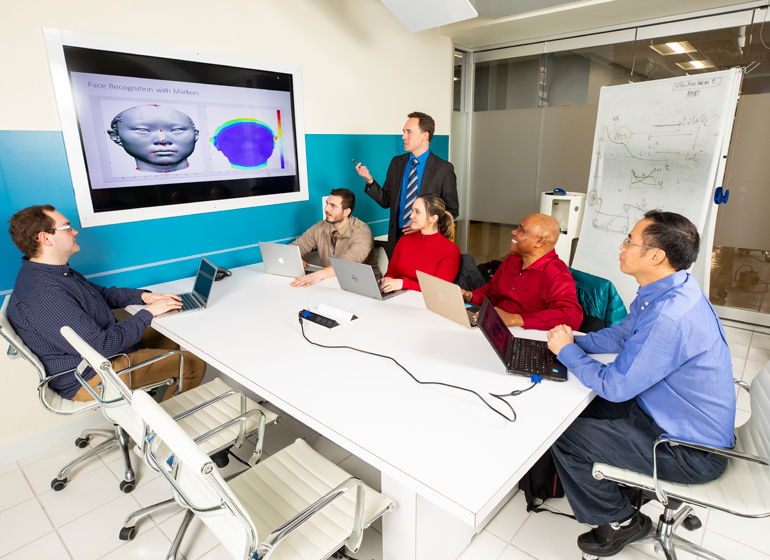Until recently, machines performing tasks in the workforce, such as data processing and customer service, might have seemed to the average American like plots out of a science fiction novel.
Artificial intelligence has existed in some form or another for 60 years. Now, with many smartphone apps, including Uber and digital voice assistants like Amazon’s Alexa, AI is rapidly becoming a part of our daily lives.
Brent Leland, board chair of Advancing AI Wisconsin, a nonprofit organization striving to educate businesses and individuals about AI’s vast potential, defines AI as “taking internal data in a company and combining that with external data sources.” Leland is the co-founder of Delafield technology consulting firm
Cimphoni.
In modern day workplaces, artificial intelligence often performs repetitive tasks, including data entry. AI is also rapidly augmenting more “human” tasks, like customer service.
“We are seeing things like the chatbots scenario,” said Ken Kortas, AAIW member and information technology consulting practice leader for Wauwatosa-based accounting and consulting firm Wipfli.
AI has been incorporated in a number of Wisconsin businesses that work with large amounts of data, including large insurance companies like Milwaukee-based Northwestern Mutual Life Insurance Co. AI enables these companies to create risk profiles using client data. Northwestern also has its own innovation labs.
“Insurance companies are ahead in that way,” Leland said.
Less than two years ago, AI was perceived as more of a novelty than a valuable business tool, Leland said. Now, more mid-level Wisconsin businesses are getting on board, either by using software with AI capabilities (Google’s grammar module, for example) or by hiring a team of AI engineers.
“There are more and more companies that have done pilot projections and proof of concepts,” Leland added.
Many companies, including Milwaukee-based wine subscription service Bright Cellars and Pound Social, a subsidiary of Combined Locks -based animation software company Dodles Inc., use AI, which applies complex algorithms and natural language understanding to compile data and client information. Pound Social, for example, uses AI technologies to help Instagram users increase their targeted audience, while Bright Cellars employs quizzes to match users with wines.
“Basically, what would be a very time-consuming effort they have automated with AI. The amount of leverage is unbelievable,” said AAIW executive director Oliver Buechse.
Hiring AI engineers is a costly endeavor. A majority of AI professionals are highly educated and command hefty salaries. But integrating AI can be cost-effective for many workplaces.
“Our aim is to not have Wisconsin left behind, as the state can be a bit risk-averse. The whole purpose is to drive change,” Leland said.
A key goal of AAIW is to educate Wisconsin business owners and individuals about AI’s vast economic potential. In addition to offering a number of business workshops, the organization strives to combine an inventory of knowledge with 1,000 use cases on its website.
“We are hoping that over the next six months, we are able to build a robust inventory accessible to both businesses and individuals,” Buechse said. The organization also plans to implement a self-learning module on the site.
Wisconsin universities have recognized the importance of equipping students with up-to-date technological skills. The Milwaukee School of Engineering’s $34 million Dwight and Dian Diercks Computational Science Hall is set to open this fall, and the University of Wisconsin-Milwaukee’s Disruptive Technologies virtual and on-site lab launched last fall.
Matthew Friedel, senior lecturer at the UWM School of Information Studies, co-founded the lab with associate professor Jacques Du Plessis.
“The lab was really our efforts to work with strategic partners on evolving technology,” Friedel noted.
Friedel, also a software developer, said initiatives such as the Disruptive Technologies Lab, along with his practical and theoretical courses, prepare students to meet the technological demands of the ever-changing workforce after graduation, and encourage innovation and entrepreneurial thinking.
“The cool part is, I get to help create the workforce that’s going to do that for Wisconsin companies. We’re building practical applications in the area so, when students go out, they will have built some type of software,” he said. “Some students do go out and create their own companies.”
Despite its vast economic potential, some companies are still reluctant to integrate AI technologies in their workplaces. Local experts attribute this to fear of the unknown.
“When your co-worker is a bot, there is this fear, ‘Is this going to take my job?’” Leland said.
However, he and experts agree that AI will augment, not replace, many jobs.
Buechse and Leland believe that Wisconsin will face a significant labor shortage in the near future. However, this can be remedied. Companies that lack skilled workers can use AI to help increase worker productivity.
“The thing you hear is that it’s so hard for businesses to find and keep employees,” Leland said. “Using AI could help mitigate these losses. There are more opportunities than risk.”
Buechse said that if too many Wisconsin companies are unwilling to integrate AI technologies into their workplaces, the state could potentially face a net job loss in the next decade.
“We would become what I call ‘the digital Rust Belt,’” Buechse said.
According to Kortas, jobs that involve a lot of repetition, among them truck driving and data processing, are likely to be the most affected by AI.
“I think the reality is, all jobs will be impacted in some form. But we will have a whole new industry of jobs created because of AI,” he said.


